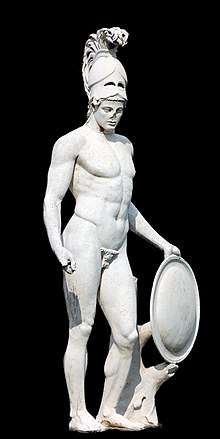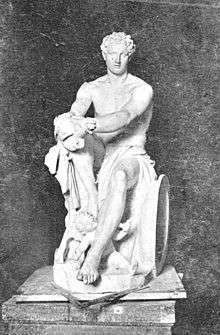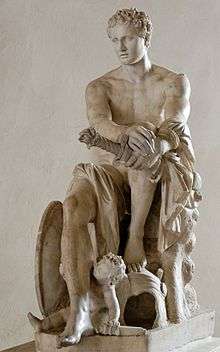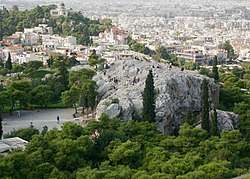Ares
Ares (/ˈɛəriːz/; Ancient Greek: Ἄρης, Áres [árɛːs]) is the Greek god of war. He is one of the Twelve Olympians, the son of Zeus and Hera.[1] In Greek literature, he often represents the physical or violent and untamed aspect of war and is the personification of sheer brutality, in contrast to his sister, the armored Athena, whose functions as a goddess of intelligence include military strategy and generalship.[2]
| Ares | |
|---|---|
God of war | |
 Statue of Ares from Hadrian's Villa | |
| Abode | Mount Olympus, Thrace, Macedonia, Thebes, Sparta & Mani |
| Symbols | Sword, spear, shield, helmet, chariot, flaming torch, dog, boar, vulture |
| Personal information | |
| Parents | Zeus and Hera |
| Siblings | Aeacus, Angelos, Aphrodite, Apollo, Artemis, Athena, Dionysus, Eileithyia, Enyo, Eris, Ersa, Hebe, Helen of Troy, Hephaestus, Heracles, Hermes, Minos, Pandia, Persephone, Perseus, Rhadamanthus, the Graces, the Horae, the Litae, the Muses, the Moirai |
| Consort | Aphrodite and various others |
| Children | Erotes (Eros and Anteros), Phobos, Deimos, Phlegyas, Harmonia, Enyalios, Thrax, Oenomaus, and Amazons |
| Roman equivalent | Mars |
| Norse equivalent | Týr |
| Hinduism equivalent | Kartikeya |
The Greeks were ambivalent toward Ares: although he embodied the physical valor necessary for success in war, he was a dangerous force, "overwhelming, insatiable in battle, destructive, and man-slaughtering."[3] His sons Phobos (Fear) and Deimos (Terror) and his lover, or sister, Enyo (Discord) accompanied him on his war chariot.[4] In the Iliad, his father Zeus tells him that he is the god most hateful to him.[5] An association with Ares endows places and objects with a savage, dangerous, or militarized quality.[6] His value as a war god is placed in doubt: during the Trojan War, Ares was on the losing side, while Athena, often depicted in Greek art as holding Nike (Victory) in her hand, favoured the triumphant Greeks.[3]
Ares plays a relatively limited role in Greek mythology as represented in literary narratives, though his numerous love affairs and abundant offspring are often alluded to.[7] When Ares does appear in myths, he typically faces humiliation.[8] He is well known as the lover of Aphrodite, the goddess of love, who was married to Hephaestus, god of craftsmanship.[9] The most famous story related to Ares and Aphrodite shows them exposed to ridicule through the wronged husband's device.[10]
The counterpart of Ares among the Roman gods is Mars,[11] who as a father of the Roman people was given a more important and dignified place in ancient Roman religion as a guardian deity. During the Hellenization of Latin literature, the myths of Ares were reinterpreted by Roman writers under the name of Mars. Greek writers under Roman rule also recorded cult practices and beliefs pertaining to Mars under the name of Ares. Thus in the classical tradition of later Western art and literature, the mythology of the two figures later became virtually indistinguishable.
Names
The etymology of the name Ares is traditionally connected with the Greek word ἀρή (arē), the Ionic form of the Doric ἀρά (ara), "bane, ruin, curse, imprecation".[12] There may also be a connection with the Roman god of war, Mars, via hypothetical Proto-Indo-European *M̥rēs; compare Ancient Greek μάρναμαι (marnamai), "I fight, I battle".[13] Walter Burkert notes that "Ares is apparently an ancient abstract noun meaning throng of battle, war."[14] R. S. P. Beekes has suggested a Pre-Greek origin of the name.[15]
The earliest attested form of the name is the Mycenaean Greek 𐀀𐀩, a-re, written in the Linear B syllabic script.[16][17][18]
The adjectival epithet, Areios, was frequently appended to the names of other gods when they took on a warrior aspect or became involved in warfare: Zeus Areios, Athena Areia, even Aphrodite Areia. In the Iliad, the word ares is used as a common noun synonymous with "battle."[3]
Inscriptions as early as Mycenaean times, and continuing into the Classical period, attest to Enyalios as another name for the god of war.[n 1]
Character, origins, and worship

Ares was one of the Twelve Olympians in the archaic tradition represented by the Iliad and Odyssey. Zeus expresses a recurring Greek revulsion toward the god when Ares returns wounded and complaining from the battlefield at Troy:
Then looking at him darkly Zeus who gathers the clouds spoke to him:
"Do not sit beside me and whine, you double-faced liar.
To me you are the most hateful of all gods who hold Olympus.
Forever quarrelling is dear to your heart, wars and battles.
...
And yet I will not long endure to see you in pain, since
you are my child, and it was to me that your mother bore you.
But were you born of some other god and proved so ruinous
long since you would have been dropped beneath the gods of the bright sky."[21]
This ambivalence is expressed also in the Greeks' association of Ares with the Thracians, whom they regarded as a barbarous and warlike people.[22] Thrace was Ares's birthplace, his true home, and his refuge after the affair with Aphrodite was exposed to the general mockery of the other gods.[n 2]
A late-6th-century BC funerary inscription from Attica emphasizes the consequences of coming under Ares's sway:
Stay and mourn at the tomb of dead Kroisos
Whom raging Ares destroyed one day, fighting in the foremost ranks.[23]
Ares in Sparta
In Sparta, Ares was viewed as a model soldier: his resilience, physical strength, and military intelligence were unrivaled. An ancient statue, representing the god in chains, suggests that the martial spirit and victory were to be kept in the city of Sparta. That the Spartans admired him is indicative of the cultural divisions that existed between themselves and other Greeks, especially the Athenians (see Pelopponesian War).
Ares in the Arabian Peninsula
Ares was also worshipped by the inhabitants of Tylos. It is not known if he was worshipped in the form of an Arabian god (or which one) or if he was worshipped in his Greek form.[24]
Ares in the Scythians
According to Herodotus' Histories, the Scythians worshipped a god he equated with the Greek Ares; unlike most other Scythian gods, he does not offer the indigenous name for this deity. While ranking beneath Tabiti, Api and Papaios in the divine hierarchy, this god was apparently worshipped differently from other Scythian gods, with statues and complex altars devoted to him. This type of worship is noted to be present among the Alans.[25]
Noting how Greek mythological Amazons are devotees of Ares and most likely based on Scythian warriors, some researchers have considered the possibility that a Scythian warrior women cult of this deity existed.[26] Others have also posited that the "Sword of Mars" alludes to the Huns having adopted this deity.[27]
Ares in Ethiopia
Maḥrem, the principal god of the kings of Aksum prior to the 4th century AD, was always equated with Ares. In their Greek inscriptions, the kings invoke Ares. In bilingual inscriptions, where the Ethiopic has Maḥrem the Greek will have Ares. The anonymous king who put up the Monumentum Adulitanum in the late 2nd or early 3rd century refers to "my greatest god, Ares, who also begat me, through whom I brought under my sway" various peoples. The monumental throne celebrating the king's conquests was itself dedicated to Ares.[28] In the early 4th century, the last pagan king of Aksum, Ezana, referred to "the one who brought me forth, the invincible Ares".[29]
Attributes

Ares’ attributes were a helmet, shield, and sword or spear.[30] The birds of Ares (Ornithes Areioi) were a flock of feather-dart-dropping birds that guarded the Amazons' shrine of the god on a coastal island in the Black Sea.[31]
Cult and ritual
Although Ares received occasional sacrifice from armies going to war, the god had a formal temple and cult at only a few sites.[32] At Sparta, however, each company of youths sacrificed a puppy to Enyalios before engaging in ritual fighting at the Phoebaeum.[n 3] The chthonic night-time sacrifice of a dog to Enyalios became assimilated to the cult of Ares.[34]
Just east of Sparta stood an archaic statue of Ares in chains, to show that the spirit of war and victory was to be kept in the city.[n 4]
The Temple of Ares in the agora of Athens, which Pausanias saw in the second century AD, had been moved and rededicated there during the time of Augustus. Essentially, it was a Roman temple to the Augustan Mars Ultor.[32] From archaic times, the Areopagus, the "mount of Ares" at some distance from the Acropolis, was a site of trials. Paul the Apostle later preached about Christianity there. Its connection with Ares, perhaps based on a false etymology, is etiological myth. A second temple to Ares has been located at the archaeological site of Metropolis in what is now Western Turkey.[36]
Attendants
Ares's sons Deimos ("Terror" or "Dread") and Phobos ("Fear") are his companions in war.[37] According to Hesiod, they were also his children, born to him by Aphrodite.[38] Eris, the goddess of discord, or Enyo, the goddess of war, bloodshed, and violence, was considered the sister and companion of the violent Ares.[39] In at least one tradition, Enyalius, rather than another name for Ares, was his son by Enyo.[40]
Ares may also be accompanied by Kydoimos, the daemon of the din of battle; the Makhai ("Battles"); the "Hysminai" ("Acts of manslaughter"); Polemos, a minor spirit of war, or only an epithet of Ares, since it has no specific dominion; and Polemos's daughter, Alala, the goddess or personification of the Greek war-cry, whose name Ares uses as his own war-cry. Ares's sister Hebe ("Youth") also draws baths for him.
According to Pausanias, local inhabitants of Therapne, Sparta, recognized Thero, "feral, savage," as a nurse of Ares.[41]
Consorts and children
The union of Ares and Aphrodite created the gods Eros, Anteros, Phobos, Deimos, and Harmonia. Other versions include Alcippe as one of his daughters.
Upon one occasion, Ares incurred the anger of Poseidon by slaying his son, Halirrhothius, because he had raped Alcippe, a daughter of the war-god. For this deed, Poseidon summoned Ares to appear before the tribunal of the Olympic gods, which was held upon a hill in Athens. Ares was acquitted. This event is supposed to have given rise to the name Areopagus (or Hill of Ares), which afterward became famous as the site of a court of justice.[42]
Accounts tell of Cycnus (Κύκνος) of Macedonia, a son of Ares who was so murderous that he tried to build a temple with the skulls and the bones of travellers. Heracles slaughtered this abominable monstrosity, engendering the wrath of Ares, whom the hero wounded in conflict.[43]
List of Ares's consorts and children
| Divine Consorts | Children | Mortal Consorts | Children |
|---|---|---|---|
| Aphrodite | • Phobos | Aerope | • Aeropus |
| • Deimos | Aglauros | • Alcippe | |
| • Harmonia[44] | Althaea | • Meleager (possibly) | |
| • Eros (part of the Erotes) | Astynome | • Diocles | |
| • Anteros (part of the Erotes) | Astyoche, daughter of Actor | • Ascalaphus | |
| • Himeros (part of the Erotes) | • Ialmenus | ||
| • Pothos (part of the Erotes) | Atalanta | • Parthenopaeus (possibly) | |
| Calliope (Muse) | • Edonus (possibly) | Caldene, daughter of Pisidus | • Solymus (possibly) |
| • Mygdon | Chryse or | • Phlegyas | |
| • Odomantus (possibly) | Dotis | ||
| • Biston (possibly) | Critobule | • Pangaeus[45] | |
| Terpsichore (Muse) | Demonice | • Euenus | |
| Eos | *no offspring mentioned | • Molus | |
| Enyo | • Enyalius | • Pylus | |
| Erinys of Telphusa (unnamed) | • Dragon of Thebes | • Thestius | |
| Persephone | *wooed her unsuccessfully | Pisidice | |
| Unknown | • Nike | Dormothea | • Stymphelus[46] |
| Eurythoe the Danaid | • Oenomaus | ||
| Semi-divine Consorts | Children | Helice | • Strymon |
| Aegina | • Sinope (possibly)[47] | Leodoce (?)[48] | no known offspring |
| Callirrhoe, daughter of Nestus | • Biston (possibly) | Otrera | • Antiope |
| • Edonus (possibly) | • Hippolyta | ||
| • Odomantus (possibly) | • Melanippe | ||
| Cleobula | • Cycnus[49] | • Penthesilea | |
| Cyrene[50] | • Crestone[51] | Parnassa | • Sinope (possibly)[47] |
| • Diomedes of Thrace | Pelopia or | • Cycnus | |
| Harmonia | • The Amazons | Pyrene | • Lycaon (possibly) |
| Harpinna, daughter of Asopus | • Oenomaus | Phylonome | • Lycastus |
| Sterope (Pleiad) | • Parrhasius | ||
| • Evenus | Protogeneia | • Oxylus | |
| Tanagra, daughter of Asopus | *competed with Hermes over her | Reate | • Medrus[49] |
| Tereine, daughter of Strymon | • Thrassa, mother of Polyphonte | Sete, sister of Rhesus | • Bithys, eponym of the Thracian tribe of Bithyae[52] |
| Thebe | *no offspring mentioned | Theogone | • Tmolus[53] |
| Triteia | • Melanippus | Thracia | • Ismarus[49] |
| Unknown woman | • Alcon of Thrace[54] | ||
| Unknown woman | • Calydon[49] | ||
| Unknown woman | • Chalyps, eponym of the Chalybes[55] | ||
| Unknown woman | • Cheimarrhoos[56] | ||
| Unknown woman | • Dryas | ||
| Unknown woman | • Evadne[49] | ||
| Unknown woman | • Hyperbius | ||
| Unknown woman | • Lycus of Libya[57] | ||
| Unknown woman | • Nisos (possibly) | ||
| Unknown woman | • Oeagrus[58] | ||
| Unknown woman | • Paeon | ||
| Unknown woman | • Portheus (Porthaon) | ||
| Unknown woman | • Tereus |
Hymns to Ares
- Homeric Hymn 8 to Ares (trans. Evelyn-White) (Greek epic 7th to 4th centuries BC)
- "Ares, exceeding in strength, chariot-rider, golden-helmed, doughty in heart, shield-bearer, Saviour of cities, harnessed in bronze, strong of arm, unwearying, mighty with the spear, O defence of Olympus, father of warlike Victory, ally of Themis, stern governor of the rebellious, leader of righteous men, sceptred King of manliness, who whirl your fiery sphere among the planets in their sevenfold courses through the aether wherein your blazing steeds ever bear you above the third firmament of heaven; hear me, helper of men, giver of dauntless youth! Shed down a kindly ray from above upon my life, and strength of war, that I may be able to drive away bitter cowardice from my head and crush down the deceitful impulses of my soul. Restrain also the keen fury of my heart which provokes me to tread the ways of blood-curdling strife. Rather, O blessed one, give you me boldness to abide within the harmless laws of peace, avoiding strife and hatred and the violent fiends of death."[59]
- Orphic Hymn 65 to Ares (trans. Taylor) (Greek hymns 3rd century BCE to 2nd century CE)
- "To Ares, Fumigation from Frankincense. Magnanimous, unconquered, boisterous Ares, in darts rejoicing, and in bloody wars; fierce and untamed, whose mighty power can make the strongest walls from their foundations shake: mortal-destroying king, defiled with gore, pleased with war's dreadful and tumultuous roar. Thee human blood, and swords, and spears delight, and the dire ruin of mad savage fight. Stay furious contests, and avenging strife, whose works with woe embitter human life; to lovely Kyrpis [Aphrodite] and to Lyaios [Dionysos] yield, for arms exchange the labours of the field; encourage peace, to gentle works inclined, and give abundance, with benignant mind."
Mythology
Founding of Thebes
One of the roles of Ares was expressed in mainland Greece as the founding myth of Thebes: Ares was the progenitor of the water-dragon slain by Cadmus, for the dragon's teeth were sown into the ground as if a crop and sprang up as the fully armored autochthonic Spartoi. Cadmus placed himself in the god's service for eight years atoning for the crime of killing Ares’ dragon.[30] To propitiate Ares, Cadmus took as a bride Harmonia, a daughter of Ares's union with Aphrodite. In this way, Cadmus harmonized all strife and founded the city of Thebes.[60]

Ares and Aphrodite
_Surprised_by_Vulcan_-_Guillemot_Alexandre_Charles.jpg)
In the tale sung by the bard in the hall of Alcinous,[61] the Sun-god Helios once spied Ares and Aphrodite having sex secretly in the hall of Hephaestus, her husband. He reported the incident to Hephaestus. Contriving to catch the illicit couple in the act, Hephaestus fashioned a finely-knitted and nearly invisible net with which to snare them. At the appropriate time, this net was sprung, and trapped Ares and Aphrodite locked in very private embrace.[n 5]
But Hephaestus was not satisfied with his revenge, so he invited the Olympian gods and goddesses to view the unfortunate pair. For the sake of modesty, the goddesses demurred, but the male gods went to witness the sight. Some commented on the beauty of Aphrodite, others remarked that they would eagerly trade places with Ares, but all who were present mocked the two. Once the couple was released, the embarrassed Ares returned to his homeland, Thrace, and Aphrodite went to Paphos.[n 5]
In a much later interpolated detail, Ares put the young soldier Alectryon by his door to warn them of Helios's arrival as Helios would tell Hephaestus of Aphrodite's infidelity if the two were discovered, but Alectryon fell asleep on guard duty.[62] Helios discovered the two and alerted Hephaestus. The furious Ares turned the sleepy Alectryon into a rooster which now always announces the arrival of the sun in the morning.
Ares and the giants
In one archaic myth, related only in the Iliad by the goddess Dione to her daughter Aphrodite, two chthonic giants, the Aloadae, named Otus and Ephialtes, threw Ares into chains and put him in a bronze urn, where he remained for thirteen months, a lunar year. "And that would have been the end of Ares and his appetite for war, if the beautiful Eriboea, the young giants' stepmother, had not told Hermes what they had done," she related.[63] "In this one suspects a festival of licence which is unleashed in the thirteenth month."[64]
Ares was held screaming and howling in the urn until Hermes rescued him, and Artemis tricked the Aloadae into slaying each other. In Nonnus's Dionysiaca[65] Ares also killed Ekhidnades, the giant son of Echidna, and a great enemy of the gods. Scholars have not concluded whether the nameless Ekhidnades ("of Echidna's lineage") was entirely Nonnus's invention or not.
Iliad
In the Iliad,[66] Homer represented Ares as having no fixed allegiances, rewarding courage on both sides: he promised Athena and Hera that he would fight on the side of the Achaeans (Iliad V.830–834, XXI.410–414), but Aphrodite persuaded Ares to side with the Trojans. During the war, Diomedes fought with Hector and saw Ares fighting on the Trojans' side. Diomedes called for his soldiers to fall back slowly (V.590–605).
Athene or Athena, Ares's sister, saw his interference and asked Zeus, his father, for permission to drive Ares away from the battlefield, which Zeus granted (V.711–769). Hera and Athena encouraged Diomedes to attack Ares (V.780–834). Diomedes thrust with his spear at Ares, with Athena driving it home, and Ares's cries made Achaeans and Trojans alike tremble (V.855–864). Ares fled to Mount Olympus, forcing the Trojans to fall back.
When Hera mentioned to Zeus that Ares's son, Ascalaphus, was killed, Ares overheard and wanted to join the fight on the side of the Achaeans, disregarding Zeus's order that no Olympic god should enter the battle, but Athena stopped him (XV.110–128). Later, when Zeus allowed the gods to fight in the war again (XX.20–29), Ares was the first to act, attacking Athena to avenge himself for his previous injury. Athena overpowered him by striking Ares with a boulder (XXI.391–408).
Renaissance
In Renaissance and Neoclassical works of art, Ares's symbols are a spear and helmet, his animal is a dog, and his bird is the vulture. In literary works of these eras, Ares is replaced by the Roman Mars, a romantic emblem of manly valor rather than the cruel and blood-thirsty god of Greek mythology.
In popular culture
See also
Attendants
Similar deities in non-Greek cultures
Notes and references
Notes
- Enyalios is thought to be attested on the KN V 52 tablet as 𐀁𐀝𐀷𐀪𐀍, e-nu-wa-ri-jo.[19][20]
- Homer Odyssey viii. 361; for Ares/Mars and Thrace, see Ovid, Ars Amatoria, book ii.part xi.585, which tells the same tale: "Their captive bodies are, with difficulty, freed, at your plea, Neptune: Venus runs to Paphos: Mars heads for Thrace."; for Ares/Mars and Thrace, see also Statius, Thebaid vii. 42; Herodotus, iv. 59, 62.
- "Here each company of youths sacrifices a puppy to Enyalius, holding that the most valiant of tame animals is an acceptable victim to the most valiant of the gods. I know of no other Greeks who are accustomed to sacrifice puppies except the people of Colophon; these too sacrifice a puppy, a black bitch, to the Wayside Goddess".[33]
- "Opposite this temple [the temple of Hipposthenes] is an old image of Enyalius in fetters. The idea the Lacedaemonians express by this image is the same as the Athenians express by their Wingless Victory; the former think that Enyalius will never run away from them, being bound in the fetters, while the Athenians think that Victory, having no wings, will always remain where she is".[35]
- "Odyssey, 8.295".
[In Robert Fagles's translation]: ... and the two lovers, free of the bonds that overwhelmed them so, sprang up and away at once, and the Wargod sped Thrace, while Love with her telltale laughter sped to Paphos ...
References
- Hesiod, Theogony 921 (Loeb Classical Library numbering); Iliad, 5.890–896. By contrast, Ares's Roman counterpart Mars was born from Juno alone, according to Ovid (Fasti 5.229–260).
- Walter Burkert, Greek Religion (Blackwell, 1985, 2004 reprint, originally published 1977 in German), pp. 141; William Hansen, Classical Mythology: A Guide to the Mythical World of the Greeks and Romans (Oxford University Press, 2005), p. 113.
- Burkert, Greek Religion, p. 169.
- Burkert, Greek Religion, p.169.
- Iliad 5.890–891.
- Hansen, Classical Mythology, pp. 114–115.
- Hansen, Classical Mythology, pp. 113–114; Burkert, Greek Religion, p. 169.
- Hansen, Classical Mythology, pp. 113–114. See for instance Ares and the giants below.
- In the Iliad, however, the wife of Hephaestus is Charis, "Grace," as noted by Burkert, Greek Religion, p. 168.
- Odyssey 8.266–366; Hansen, Classical Mythology, pp. 113–114.
- Larousse Desk Reference Encyclopedia, The Book People, Haydock, 1995, p. 215.
- ἀρή, Georg Autenrieth, A Homeric Dictionary. ἀρή. Liddell, Henry George; Scott, Robert; A Greek–English Lexicon at the Perseus Project.
- μάρναμαι in Liddell and Scott.
- Walter Burkert, Greek Religion (Harvard) 1985:pt III.2.12 p. 169.
- R. S. P. Beekes, Etymological Dictionary of Greek, Brill, 2009, pp. 129–130.
- Gulizio, Joannn. "A-re in the Linear B Tablets and the Continuity of the Cult of Ares in the Historical Period" (PDF). Journal of Prehistoric Religion. 15: 32–38.
- Raymoure, K.A. (2012). "a-re". Minoan Linear A & Mycenaean Linear B. Deaditerranean.
- "The Linear B word a-re". Palaeolexicon, Word study tool of ancient languages.
- Chadwick, John (1976). The Mycenaean World. Cambridge, UK: Cambridge University Press. p. 88. ISBN 0-521-29037-6. At Google Books.
- Raymoure, K.A. "e-nu-wa-ri-jo". Minoan Linear A & Mycenaean Linear B. Deaditerranean. "KN 52 V + 52 bis + 8285 (unknown)". DĀMOS: Database of Mycenaean at Oslo. University of Oslo. Archived from the original on 2014-03-19.
- Iliad, Book 5, lines 798–891, 895–898 in the translation of Richmond Lattimore.
- Iliad 13.301; Ovid, Ars Amatoria, II.10.
- Athens, NM 3851 quoted in Andrew Stewart, One Hundred Greek Sculptors: Their Careers and Extant Works, Introduction: I. "The Sources"
- الاحتلال المقدوني للبحرين ص ١٢٨
- Sulimirski, T. (1985). "The Scyths" in: Fisher, W. B. (Ed.) The Cambridge History of Iran, Vol. 2: The Median and Achaemenian Periods. Cambridge: Cambridge University Press. ISBN 0-521-20091-1. pp. 158–159.
- Chisholm, Hugh, ed. (1911). "Amazons". Encyclopædia Britannica. 1 (11th ed.). Cambridge University Press.
- Geary, Patrick J. (1994). "Chapter 3. Germanic Tradition and Royal Ideology in the Ninth Century: The Visio Karoli Magni". Living with the Dead in the Middle Ages. Cornell University Press. p. 63. ISBN 978-0-8014-8098-0.
- Glen Bowersock, The Throne of Adulis: Red Sea Wars on the Eve of Islam (Oxford University Press, 2013), pp. 45, 47–48.
- Bowersock, Throne of Adulis, p. 69.
- Roman, L., & Roman, M. (2010). Encyclopedia of Greek and Roman mythology., p. 80, at Google Books
- Argonautica (ii.382ff and 1031ff; Hyginus, Fabulae 30.
- Burkert, Greek Religion, p. 170.
- Pausanias, 3.14.9.
- "Ares". academic.eb.com/levels/collegiate/article/9344. Britannica Academic, Encyclopædia Britannica. 2007-10-10. Retrieved 2017-01-16.
- Pausanias, 3.15.7.
- "City of mother goddess opens to tourism". Hurriyet Daily News. August 21, 2014. Retrieved January 27, 2018.
- Iliad 4.436f, and 13.299f' Hesiod's Shield of Heracles 191, 460; Quintus Smyrnaeus, 10.51, etc.
- Hesiod, Theogony 934f.
- Wolfe, Jessica (2005). "Spenser, Homer, and the mythography of strife". Renaissance Quarterly. 58: 1220+ – via Gale General Reference Center.
- Eustathius on Homer, 944
- Pausanias, Description of Greece, 3. 19. 7 – 8
- Berens, E.M.: Myths and Legends of Ancient Greece and Rome, page 113. Project Gutenberg, 2007.
- Bibliotheca 2. 5. 11 & 2. 7. 7
- Scholia on Homer, Iliad B, 494, p. 80, 43 ed. Bekk. as cited in Hellanicus' Boeotica
- Pseudo-Plutarch, On Rivers, 3. 2
- Pseudo-Plutarch, On Rivers, 19. 1
- Scholia on Apollonius Rhodius, Argonautica, 2. 946
- Hyginus, Fabulae, 159
- Murray, John (1833). A Classical Manual, being a Mythological, Historical and Geographical Commentary on Pope's Homer, and Dryden's Aeneid of Virgil with a Copious Index. Albemarle Street, London. p. 70.
- Bibliotheca 2. 5. 8
- Tzetzes on Lycophron, 499: Thrace was said to have been called Crestone after her.
- Stephanus of Byzantium, s. v. Bithyai
- Pseudo-Plutarch, On Rivers, 7. 5
- Hyginus, Fabulae, 173
- Scholia on Apollonius Rhodius, Argonautica, 2. 373
- Scholia on Hesiod, Works and Days, 1, p. 28
- Pseudo-Plutarch, Greek and Roman Parallel Stories, 23
- Nonnus, Dionysiaca XIII.428
- Homeric Hymn to Ares.
- Burkert, Greek Religion, p.169.
- Odyssey 8.300
- Gallagher, David (2009-01-01). Avian and Serpentine. Brill Rodopi. ISBN 978-90-420-2709-1.
- Iliad 5.385–391.
- Burkert (1985). Greek Religion. p. 169.
- Nonnus, Dionysiaca 18. 274 ff; Theoi.com, "Ekhidnades".
- References to Ares's appearance in the Iliad are collected and quoted at www.theoi.com: Ares Myths 2

